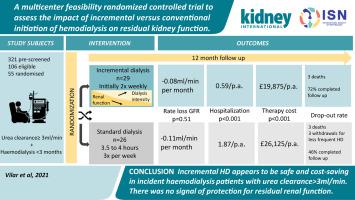Kidney International ( IF 14.8 ) Pub Date : 2021-08-19 , DOI: 10.1016/j.kint.2021.07.025 Enric Vilar 1 , Raja M Kaja Kamal 1 , James Fotheringham 2 , Amanda Busby 3 , Jocelyn Berdeprado 4 , Ewa Kislowska 4 , David Wellsted 3 , Bassam Alchi 5 , James O Burton 6 , Andrew Davenport 7 , Ken Farrington 1

|
Twice-weekly hemodialysis, as part of incremental initiation, has reported benefits including preservation of residual kidney function (RKF). To explore this, we initiated a randomized controlled feasibility trial examining 55 incident hemodialysis patients with urea clearance of 3 ml/min/1.73 m2 or more across four centers in the United Kingdom randomized to standard or incremental schedules for 12 months. Incremental hemodialysis involved twice-weekly sessions, upwardly adjusting hemodialysis dose as RKF was lost, maintaining total (Dialysis+Renal) Std Kt/V above 2. Standard hemodialysis was thrice weekly for 3.5-4 hours, minimum Dialysis Std Kt/V of 2. Primary outcomes were feasibility parameters and effect size of group differences in rate of loss of RKF at six months. Health care cost impact and patient-reported outcomes were explored. Around one-third of patients met eligibility criteria. Half agreed to randomization; 26 received standard hemodialysis and 29 incremental. At 12 months, 21 incremental patients remained in the study vs 12 in the standard arm with no group differences in the urea clearance slope. Ninety-two percent of incremental and 75% of standard arm patients had a urea clearance of 2 ml/min/1.73 m2 or more at six months. Serious adverse events were less frequent in incremental patients (Incidence Rate Ratio 0.47, confidence interval 0.27-0.81). Serum bicarbonate was significantly lower in incremental patients indicating supplementation may be required. There were three deaths in each arm. Blood pressure, extracellular fluid and patient-reported outcomes were similar. There was no signal of benefit of incremental hemodialysis in terms of protection of RKF or Quality of Life score. Median incremental hemodialysis costs were significantly lower compared to standard hemodialysis. Thus, incremental hemodialysis appears safe and cost-saving in incident patients with adequate RKF, justifying a definitive trial.
中文翻译:

一项多中心可行性随机对照试验,评估增量与传统开始血液透析对残余肾功能的影响
每周两次血液透析,作为增量启动的一部分,报告了包括保留残余肾功能(RKF)在内的益处。为了探索这一点,我们启动了一项随机对照可行性试验,检查了 55 名尿素清除率为 3 ml/min/1.73 m 2的血液透析患者在英国的四个中心或更多中心随机分配到标准或增量计划,为期 12 个月。增量血液透析涉及每周两次,当 RKF 消失时向上调整血液透析剂量,维持总(透析+肾)标准 Kt/V 高于 2。标准血液透析每周三次,持续 3.5-4 小时,最小透析标准 Kt/V 为 2 . 主要结果是可行性参数和六个月时 RKF 丢失率的组间差异的影响大小。探讨了医疗保健成本影响和患者报告的结果。大约三分之一的患者符合资格标准。一半同意随机化;26 人接受标准血液透析,29 人接受增量血液透析。在 12 个月时,21 名增加的患者留在研究中,而标准组中有 12 名患者,尿素清除率斜率没有组间差异。六个月时有2 个或更多。增加患者的严重不良事件发生率较低(发生率比 0.47,置信区间 0.27-0.81)。增量患者的血清碳酸氢盐显着降低,表明可能需要补充。每只手臂有三人死亡。血压、细胞外液和患者报告的结果相似。在保护 RKF 或生活质量评分方面,没有迹象表明增加血液透析有益。与标准血液透析相比,增加血液透析成本的中位数显着降低。因此,对于具有足够 RKF 的事件患者,增量血液透析似乎是安全且节省成本的,这证明了确定性试验的合理性。









































 京公网安备 11010802027423号
京公网安备 11010802027423号